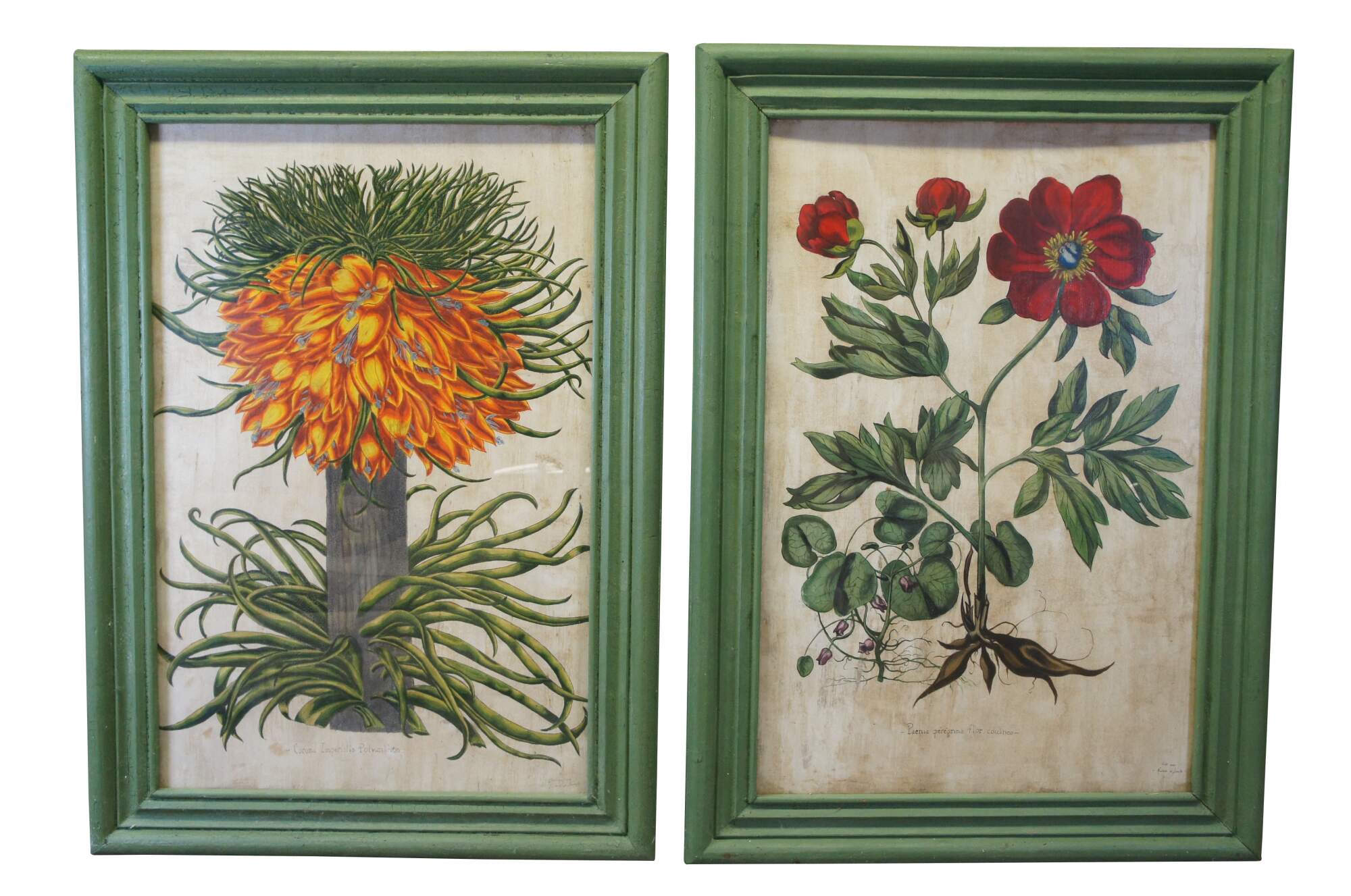
Shipping:
Free Shipping Included
Delivery:
Estimated 2-15 Business Days
Payments:
Credit Card, Check, Cash, PayPal, Apple Pay, Venmo
Returns:
30 Days 100% Money Back Guarantee, Buyer Pays Return Shipping
Description
A pair of impressive vibrant hand painted botanical still life florals, featuring Paenia peregrina flor coccineo and Corona imperialis polyanthos. Painted on a thin board, framed behind glass in green crackle painted frame. Purchased from an Antique shop in France in the 1990s.
Paeonia peregrina is a species of flowering plant in the peony family Paeoniaceae, native to Southeastern Europe and Turkey. It is an erect, herbaceous perennial with 9-lobed, deeply divided leaves. Single, glossy red flowers, 10–13 cm (4–5 in) in diameter, with prominent yellow stamens, are borne in spring (May in the Northern Hemisphere).
Fritillaria imperialis, the crown imperial, imperial fritillary or Kaiser's crown, is a species of flowering plant in the lily family Liliaceae, native to a wide stretch from the Anatolian plateau of Turkey, Iraq and Iran (i.e. Kurdistan) to Afghanistan, Pakistan, Northern India and the Himalayan foothills. It is also widely cultivated as an ornamental and reportedly naturalized in Austria, Sicily, and Washington State, USA. The common names and also the epithet "imperialis", literally "of the emperor", refer to the large circle of golden flowers, reminiscent of an emperor's crown.
Basilius Besler (1561–1629) was a respected Nuremberg apothecary and botanist, best known for his monumental florilegium, the Hortus Eystettensis (lit. The Garden at Eichstätt), 1613.
Biography
Besler was born in Nuremberg, Germany on February 13 1561, the son of Michael Besler. His first wife was Rosine Flock, who he married on 31 January 1585. Later he married Susanne Schmidt on 1 December 1596. Altogether he had 16 children. He was elected a member of the city council in 1594.
Sunflower from Hortus Eystettensis
Besler established a pharmacy, Zum Marienbild, at Nuremberg's Hay Market in 1589, and developed his own botanical garden and collection of specimens, for which he became well known.
He was curator of the garden (Eichstätt Garden) of Johann Konrad von Gemmingen (1561–1612), Prince-bishop of Eichstätt in Bavaria. The bishop was an enthusiastic botanist who derived great pleasure from his garden, which rivaled Hortus Botanicus Leiden among early European botanical gardens outside Italy.
The gardens surrounded the bishop's palace, Willibaldsburg, which was built on a hill overlooking the town. These gardens had been started in 1596 and designed by Besler's colleague, Joachim Camerarius the Younger (1534–1598), a physician and botanist. Upon Camerarius' death in 1598, Besler had the remainder of Camerarius' plants moved to Eichstätt and carried on the work of planting and supervision.
The gardens were ransacked by invading Swedish troops under Herzog Bernhard von Weimar in 1633-4, but were reconstructed and opened to the public of Eichstätt in 1998.
Besler died in Nuremberg on 13 March 1629.
Work
Fascicvlvs Rariorvm title page (1616)
In 1611, the bishop, who was already quite ill, commissioned Besler to compile a codex of the plants growing in his garden, a task which Besler took sixteen years to complete, the bishop dying shortly before the work was published in 1613. Plates were not signed at the bottom and in some the names of the artist are hidden away in the illustration. These include those of Kilian, J. Leypolt, or the initials G.R., G.H., D.K., and F.H. The names used for the plants were polynomials. This plant atlas or Florilegium was published by Ludwig Jungermann and printed in large format.
Besler did not consider himself scientist, but rather relied on the extant literature of his time including Camerarius, Clusius, Fuchs, Tabernaemontanus and Lobelius, but his work predated the introduction of many overseas plants to Germany. He indexed the collection with both the Latin and old German names.[2] At publication it represented the largest and most magnificent example of its type.
Condition
Good vintage condition, wear and distressing, crazing, distressing to frame.
Dimensions
40" x 56.5", sans 31.5" x 47.5"